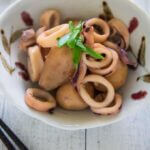
Simmered Squid and Taro is cooked in such a way that the squid pieces are plump and tender, while the taro has a fluffy soft texture. The pronounced flavour of the sweet soy simmering sauce goes very well with squid and taro.
Prep Time assumes that the squid is already cleaned.
Don't forget to see the section 'MEAL IDEAS' below the recipe card! It gives you a list of dishes that I have already posted and this recipe that can make up a complete meal. I hope it is of help to you.
- 250-300g/0.6-0.7lb squid (cleaned but skin and fins intact on the tube, note 1)
- 500g/1.1lb Japanese taro (note 2)
- 300ml/10.1fl oz dashi stock
- 1 tbsp cooking sake
- Blanched snow peas diagonally sliced thinly
-
Cut the top and bottom ends off the taro, then peel the skin vertically (note 3).
-
Cut the squid tube into 1cm/⅜" wide rings. Cut the tentacles into 3 portions.
-
Put squid pieces, dashi stock, and cooking sake into a shallow cooking pan or a frying pan and bring it to a boil.
-
When the surface of all the squid pieces becomes white and plump, transfer the squid pieces to a bowl/plate, leaving the broth in the pan.
-
Add taro to the pan and bring it to a boil.
-
Remove scum and add mirin, sugar, and soy sauce to the pan.
-
When it starts boiling again, place a drop lid on, reduce the heat to medium, and cook for about 10 minutes until the taro is almost cooked through (note 4).
-
Remove the drop lid and continue to cook until the depth of the simmering liquid is 1-1.5cm/⅜-⅝" deep. Check the flavour and stop condensing the sauce further when the flavour is about right for you (note 5).
-
Return the squid to the pan and cook for a couple of minutes, during which shake the pan occasionally to coat the ingredients with the simmering sauce.
-
Turn the heat off. Serve at any temperature (note 6) with sliced snow peas on top (if using).
1. I bought 2 similar-sized squid which weighed 450g/1lb before cleaning. Unlike many Western-style squid dishes, you don’t peel the skin off the squid tube.
2. Japanese taro is called ‘satoimo’ (里芋). It is much smaller in size and the outside skin is hairy. My local vegetable shops usually sell large taro, but they sometimes sell small taros.
My Japanese taro was about 4-5cm/1½-2" wide and 7-8cm/2¾-3⅛" long. If you can only find a large taro, cut it into smaller pieces and trim the sharp edges (it is called 'mentori' in Japanese) so that the edges of the taro pieces do not crumble when simmered.
3. Because of the hairy skin, it is easier to use a knife to peel the skin than a peeler.
4. When you put a skewer through a taro, you can get through it but with a slight resistance.
5. The depth of the simmering sauce and the strength of the flavour can vary depending on the size of the pan you are using and the size/shape of the ingredients. The idea is to leave a decent amount of liquid with just the right flavour. Do not condense it to almost no liquid as the flavour becomes too salty.
6. You can serve Simmered Squid and Taro hot, room temperature or even at cold temperature, directly from the fridge. You can keep it in the fridge for a few days.
7. Nutrition per serving as a side.
serving: 292g calories: 295kcal fat: 1.8g (3%) saturated fat: 0.5g (2%) trans fat: 0.0g polyunsaturated fat: 0.6g monounsaturated fat: 0.3g cholesterol: 175mg (58%) sodium: 387mg (16%) potassium: 915mg (26%) carbohydrates: 53g (18%) dietary fibre: 6.4g (26%) sugar: 7g protein: 14g vitamin a: 3% vitamin c: 16% calcium: 3.9% iron: 8.3%